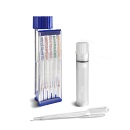Speed V-Diar 4 & Speed V-Diar 5
Rapid combined detection of Coronavirus, Rotavirus, Cryptosporidium parvum, E. coli F5 and CS31A antigens
| Presentation | Advantages | |||||||||||||||||||
|---|---|---|---|---|---|---|---|---|---|---|---|---|---|---|---|---|---|---|---|---|
|
Method : Immunochromatographic strip test Analysis : Detection of antigens specific to: Sample : Faeces Preparation : 2 minutes Reading : 15 minutes Storage : 18 months at room temperature (2°C – 30°C) Presentation : V-Diar 4: 5 tests and 10 tests Reliability : Each strip has been tested against the reference tests (ELISA, Latex agglutinin, bacteriological culture, or modified Ziehl-Nielsen staining).
|
|
| Why use Speed V Diar ? |
|---|
|
Furthermore, associations of various different pathological agents are common. |
| When use Speed V Diar ? |
|---|
|
Speed V-Diar can be used to determine which pathological agents are implicated in calf diarrhea. The Speed V-Diar test is carried out from the first signs of diarrhea, before any form of treatment is administered. On a larger scale, Speed V-Diar can be used to identify the pathological agents that are present on the farm from the first few cases of diarrhea in the calving season. This identification enables the instigation of appropriate sanitary and prophylactic measures. |
Instructions for use
Bibliography
(1) Internal study, BVT
(2) ROUSSEAU C. Pathologie du veau. Activéto, 2002, 6
(3) DEVAUX E. Les dernières données sur les colibacilloses du veau. Dépèche Vétérinaire, 2002, 718


 Neonatal diarrhea is the principal cause of mortality and growth retardation in calves under 1 month of age. They represent more than 25% of the reasons for consultation on farms (2). Due to the similarities seen in the symptoms between bacterial, viral, or parasitic diarrheas, laboratory identification is essential.
Neonatal diarrhea is the principal cause of mortality and growth retardation in calves under 1 month of age. They represent more than 25% of the reasons for consultation on farms (2). Due to the similarities seen in the symptoms between bacterial, viral, or parasitic diarrheas, laboratory identification is essential.